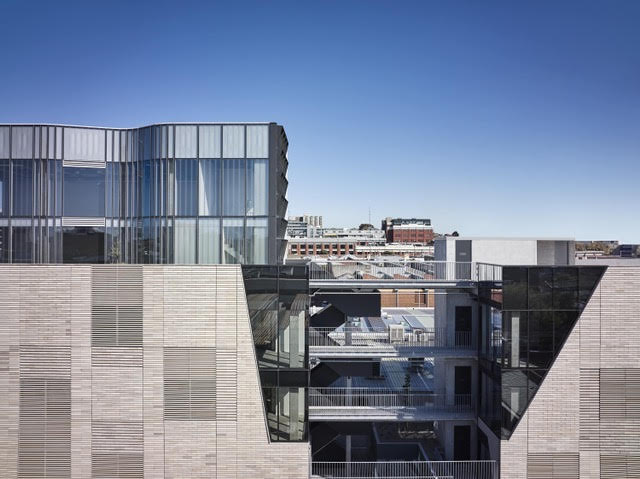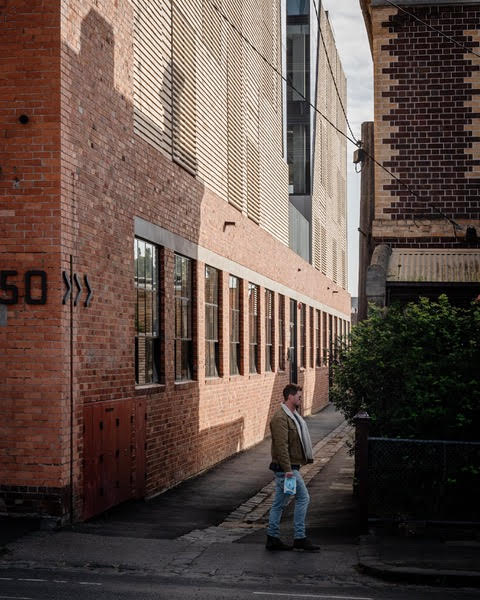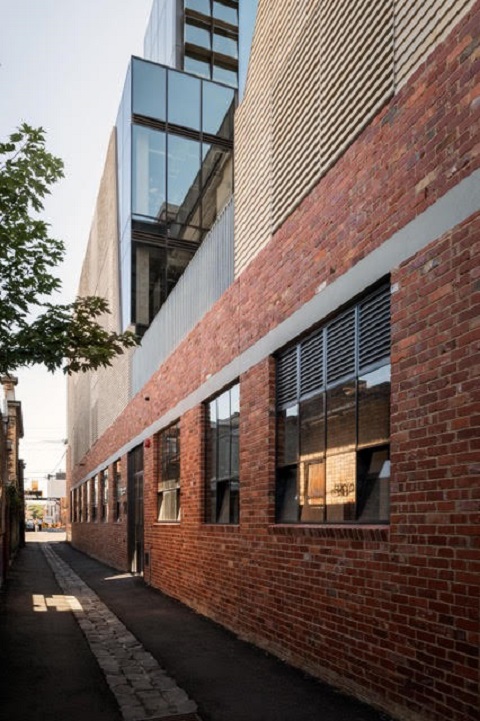Zero Gipps is the sum of its parts. Part history, part contemporary build, with a whole lot of thought, innovation and sustainable design in between. It’s a contemporary six-storey workplace building in the heart of Collingwood with human wellness, amenity and sustainability at its core.
Located at 48 Gipps Street, this long and skinny site lent itself to something unique and surprising, creating a sense of discovery at every turn.
Dare Property Group and SJB have well and truly delivered.
For starters the entrance is off the laneway, so it’s delightfully discovered rather than openly seen as a big doorway off a main street. And the building itself is split in two, so once inside the laneway entrance, there’s a beautiful central atrium and garden in between the two buildings, and a series of linking bridges with open stairways connecting the two forms on every level.

What’ so clever about this development is that Zero Gipps doesn’t feel like a recent insert into Collingwood. Rather, it feels like it has a genuine sense of history and is part of its location.
“Zero Gipps sits within this gritty context, but you come into this little sanctuary of an office building that doesn’t feel like a big corporate building but more like you’re coming into a secret garden courtyard in Collingwood. It’s not designed for large businesses, but rather smaller to medium scale ones,” says SJB director Beaudene Fulwood.
Materiality and innovative design are at the heart of the design’s success.
The limited palette of brick, concrete and glass gives a firm nod to Collingwood’s history, promoting a neutral, natural feel that speaks to the grittiness of the suburb.
For Danny Avidan, founder and director, Dare Property Group, it runs deeper. Danny was once CEO of The Discovery Group, and has owned the building, a warehouse that was home to a number of fashion businesses, for many years. So, as a nod to Danny’s history in Collingwood, the red brick base of the original building has been retained, as have the old steel square windows on the ground floor.
“It was about keeping as much of the old building as we could. It’s increasingly important to keep parts of the fabric of the city from a sustainability and historic point of view. That was quite a challenge, architecturally and construction-wise,” says Beaudene.
The highlight of Zero Gipps is most definitely the brickwork on the facade, featuring locally-sourced Krause Imperial Emperor bricks in Ghost Grey. In particular, the way SJB, working with Robertson Facade Systems, has explored materiality and used a centuries-old material with a new technology or way of laying it to get the different effects and outcomes with the bricks.
That’s what makes Zero Gipps a standout.
And behind it all sits brick inlay.

Aptly described as a canvas of brickwork, the brick inlay facade sitting above the original brickwork has a fabric-like effect, referencing the history of the building and the rag trade. Using a custom formliner and brick system, with two specially-designed moulds developed by Peter Robertson at Robertson Facade Systems, there are different patterns all over the building; the moulds enabling the Krause Imperial Emperor bricks to sit in the bed either on an angle or completely flat.
“Naturally with any change, it’s critical to make a sample panel and test the system integrity. Lux Precast helped us through this process and we could then scale the system to enable the panel production,” Peter explains.
So, across the facade, some bricks sit flat with a slight shadow gap between them, while others are laid in a stack bond and tilted in a shiplap (sawtooth) look, or in a staggered bond with the shiplap look.
“We flipped the bricks so that you see the top edge of the brick, which normally has mortar on top of it, so we exposed a part of the brick that’s not normally seen, and got them to be sitting in this shiplap angle. And we have different types of bonds running down the building to create subtle patterning, so you see stacked bricks versus staggered bricks,” explains Beaudene.
The shiplap roof is essentially reinvented in a different way with the brick patterning, creating a tactile and visually-intriguing facade, and also giving a bit of a nod to the sawtooth roofs in the area.
“The most satisfying part of Zero Gipps is how the new facade has come together to complement the old. It’s a beautiful brick that has been locally sourced and laid in a complex pattern. The beauty about it is the way we combined age-old materials with new techniques to get the brick to sit on a tilted angle, creating a sort of shiplap-like look,” says SJB director, Fiona Coakley.
Brick Inlay did more than sit bricks on an angle.

Getting bricks to sit on an angle isn’t the easiest thing to do. That’s where brick inlay shines, its custom-made moulds making this design possible. And that’s just the beginning.
“The ability to do it in a modular way, with moulds in a factory, created a really refined outcome. Fabricating it in a controlled environment while other parts are being constructed minimises waste because you can line everything up and you’re not trying to cut it on site. So there are all the benefits of quality, wastage, and you can see how finely tuned this building is – that’s a hard outcome to get on site because it all comes down to those joint lines and how everything fits together,” says Fiona.
As an added environmental bonus, using brick laid in concrete creates a fantastic thermal envelope for the building, too.
“What sets Zero Gipps apart is how we have used materiality and a new construction system in a really interesting mould to get the brick to sit in this kind of patterning. And what’s beautiful about the bricks being in this sawtooth pattern is the shadows that are cast off it, and how the light quality changes throughout the day, so the colour changes and you can see the variance in the brickwork,” adds Fiona.
Zero Gipps is more than just patterned brickwork.
Above the brick, sits an organic-shaped glass form that’s set back from the brickwork, providing areas for landscaping. This adds an extra two floors of workspace to the building and is a deliberate counterpoint to the brick facade, which is strong, grounding and monolithic.
It also creates clarity over the original warehouse and the new masonry insert, delivering a sculptural form sitting on top of the building, and producing a softer lightbox object.
On the other side of the building a restaurant and rooftop garden provide additional spaces for meeting and relaxation, while 100 solar panels work hard to deliver 35kw of energy to the building.
On the inside, exposed concrete ceilings add to the Collingwood industrial aesthetic. And, by deliberately exposing all of the services in an industrial look, there’s a reduced impact on the environment by minimising how much material is put back into the building.
On the ground floor, bricks recycled from a demolished wall are used as paving at the entrance. And a set of stairs creates an inviting amphitheatre for workers to sit and enjoy coffee. Not far away, end of trip facilities, including bike parking and tenant showers, encourage healthy lifestyle choices for workers, and are a much greener alternative to onsite car parking, which is purposely absent in this development.
Zero Gipps is a Collingwood standout. This subtly striking development has delivered a thoughtful, forward-thinking workspace that cleverly connects people with each other and their environment, and creates a unique space that truly is a Collingwood workers’ paradise.
Project details
Developer: Dare Property Group
Architect: SJB
Builder: COBEN
Precaster: Lux Precast
Landscape: Mala
Product: Brick Inlay with Krause Imperial Emperor Bricks
Photographer: Tom Roe Photography

